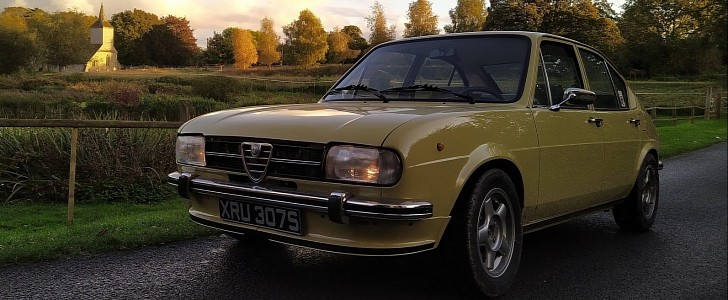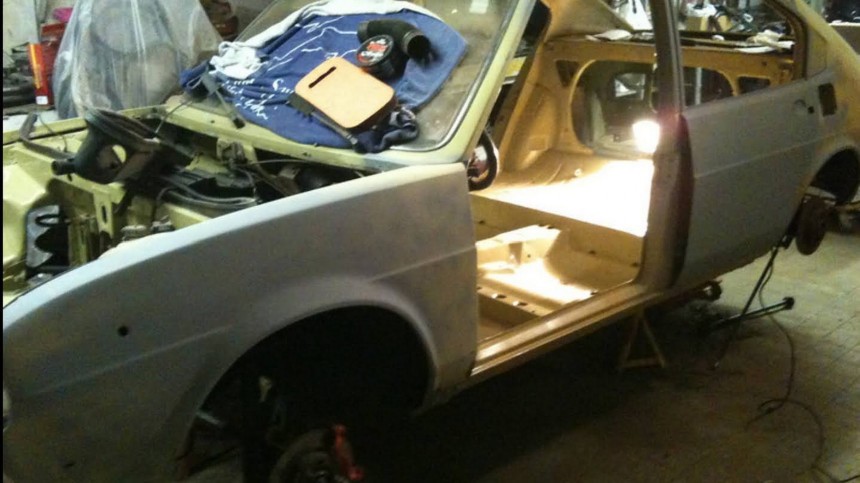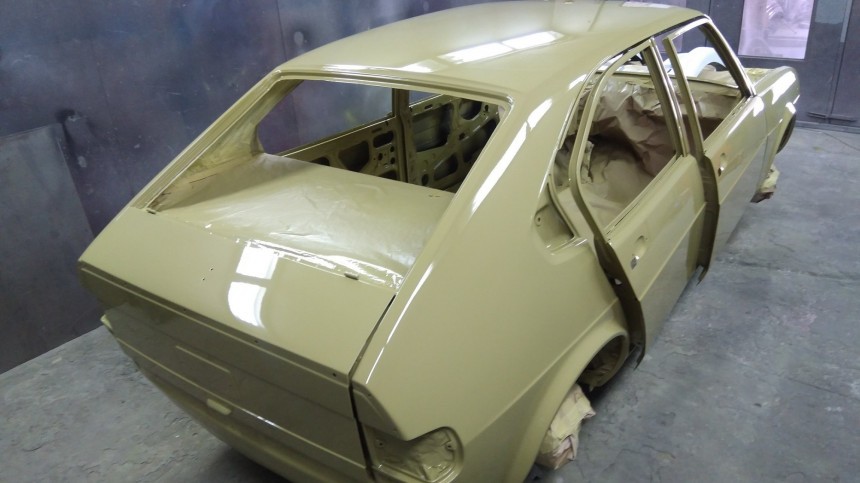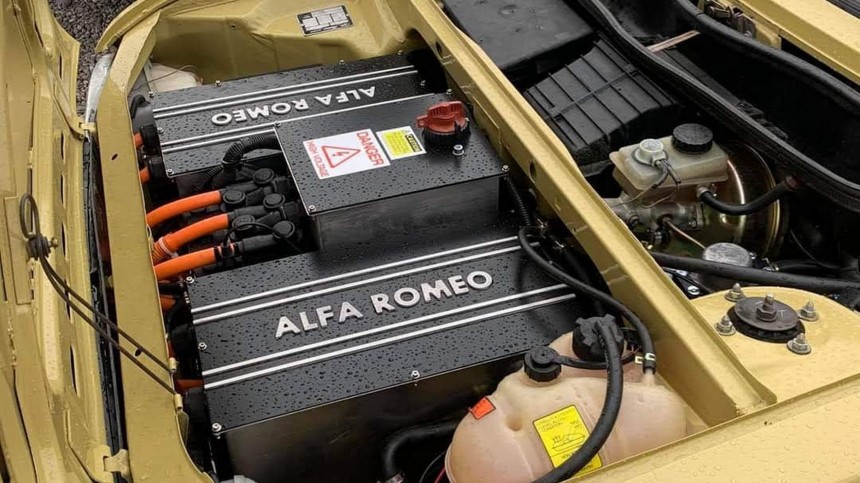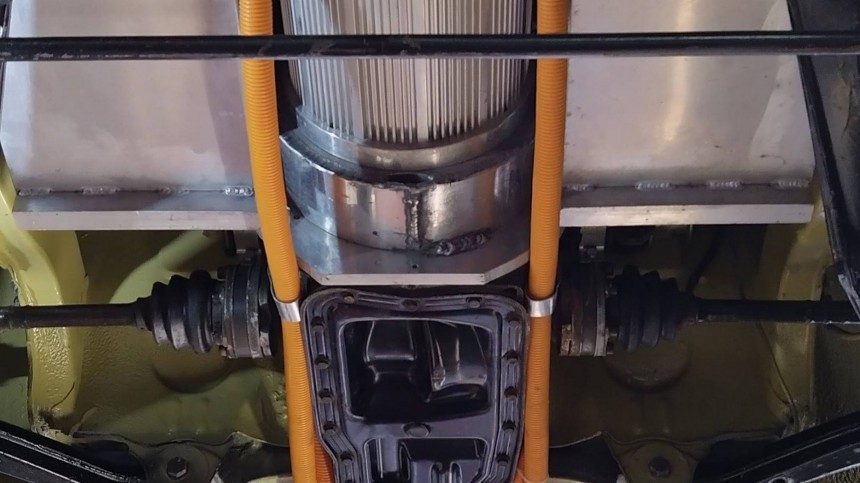Alfasuds are famous for being fun to drive and for self-destructing, thanks to rust issues. It was not their fault: Alfa Romeo just wanted to pump as many as possible, making terrible decisions in the process. The fun part led Sean Fosberry to buy one. Stopping self-destruction helped the engineer give it a new life with battery modules and an electric motor.
We found the engineer on Twitter, where he shares pictures and stories of this electric 1977 Alfasud 5M. Fosberry did all the work by himself, making the machine more than a conversion job: it was a personal accomplishment. The engineer told us how his story with this Italian car started.
“I've bought the car in 1994 from a friend who imported it from Italy. He had been working there during his university placement, and his Mk1 VW Golf engine failed, so he bought the Alfasud locally as a runabout and then decided to bring it home to the UK. Soon after he returned, I bought the car from him. I had previously owned an Alfasud, and the opportunity to buy an original Series 1 car direct from Italy was too good to miss!”
Fosberry drove it as a daily driver while he was at the university and started modifying it. The original 1.2-liter boxer engine gave place to a 1.5-liter. Eventually, that new boxer received the twin carburetor from the Cloverleaf. It was with these first upgrades that the engineer first heard about electric cars making a comeback in modern times – they were some of the earliest automobiles. However, “the technology just wasn’t there – or in reach.” Fosberry said all he had were “heavy lead-acid batteries and DC motors.”
In 1998, the engineer decided to stop the Alfasud for some much-needed repairs.
“The story goes the cars were built cheaply out of recycled Russian steel. The corrosion was helped along by the polyurethane foam injected into all of the box sections of the car to strengthen it. However, this soaked up water like a sponge, rusting the cars from the inside out. Another factor was the fact that large areas of the inside of the car were very poorly painted from the factory, if at all (inside of doors, back of the front panel, bulkhead area around the engine and gearbox). We joke that if you listen carefully when it’s raining, you can hear it rusting...”
As the to-do list got longer, he pushed it to the back of the workshop, where it sat for more than 15 years. When Fosberry decided it was the right time to restore it, finding parts for the Alfasud took him a lot of work.
“The car had a full bare bodyshell restoration. I really struggled to source missing parts – the Series 1 cars stopped production 40 years ago – and eventually had parcels delivered from all over Europe (Portugal, Spain, France, Italy, Greece...).”
Fosberry had started driving electric cars in 2013 – a Nissan Leaf made in Japan. After the body restoration process finished by 2019, he decided the Alfasud would go electric. First, he talked to conversion companies to see how they could help with his project. When the conversations went nowhere, he realized he would have to grab the bull by the horns and do everything on his own. According to him, getting started was the most challenging part of the process.
“I would say the process of design, manufacture, installation, and debugging has taken me about 18 months around my day job, life, and UK lockdowns.”
The engineer replaced the boxer engine with a Hyper 9 motor produced by NetGain. In the electric Alfasud, it works at the maximum voltage of 132V. According to Fosberry, that makes it deliver about 110 kW (148 hp), “far in excess of any of the standard boxer engines, and more than double that of the original 1200 engine.” The 1.5-liter Alfasud QV (Quadrifoglio Verde) made 77 kW (103 hp) the. An AC-X1 controller takes care of the motor.
Battery modules of a UK-made 2015 Nissan Leaf with a 24-kWh battery pack give the electric Alfasud the energy it needs. They are charged with the help of an Elcon TC 6.6 kW onboard charger and looked after by an Orion 2 BMS (battery management system). With a full charge, Fosberry can run about 60 miles with his car. It would probably go a little further if the engineer did not convert the Alfasud into a 4WD vehicle.
To do that, Fosberry used the drivetrain of a 1994 Alfa 33 4x4, as well as its front struts, outboard vented brakes, and disc brake rear axle.
“Yes, it is less efficient. Day to day, the car achieves about 3 miles per kWh. I put this down partly to the 4WD system and partly to old-fashioned wheel bearings. It drives very similarly to before. The 4WD (when active, as it's electrically selectable) reduces the understeer and wheel spin! The motor has over 200 Nm (147.5 pound-feet) of torque, far more than the standard car was designed to endure!”
Fosberry spent about £10,000 with the changes, not including his labor. Despite the keyboard specialists that tweet it is is a crime to convert a classic, he is pretty satisfied with what he achieved.
“The car is finished, for now. The only possible enhancement I'm considering is a higher capacity (around 40 kWh) battery from a second-generation Leaf to increase the range. They are the same physical size, so it should not be a problem.”
Anyone in love with the electric Alfasud will have to make one themselves. The British engineer does not even consider selling his vehicle.
“The Alfasud has been part of our family for many years. Now, it is back on the road, in regular use, and here to stay!”
Fosberry has another, "bigger project well underway" that he's currently keeping close to the chest, but he expects to "surprise a few people" when it is ready. We hope to be able to tell you about it when the British engineer can share the news.
“I've bought the car in 1994 from a friend who imported it from Italy. He had been working there during his university placement, and his Mk1 VW Golf engine failed, so he bought the Alfasud locally as a runabout and then decided to bring it home to the UK. Soon after he returned, I bought the car from him. I had previously owned an Alfasud, and the opportunity to buy an original Series 1 car direct from Italy was too good to miss!”
Fosberry drove it as a daily driver while he was at the university and started modifying it. The original 1.2-liter boxer engine gave place to a 1.5-liter. Eventually, that new boxer received the twin carburetor from the Cloverleaf. It was with these first upgrades that the engineer first heard about electric cars making a comeback in modern times – they were some of the earliest automobiles. However, “the technology just wasn’t there – or in reach.” Fosberry said all he had were “heavy lead-acid batteries and DC motors.”
“The story goes the cars were built cheaply out of recycled Russian steel. The corrosion was helped along by the polyurethane foam injected into all of the box sections of the car to strengthen it. However, this soaked up water like a sponge, rusting the cars from the inside out. Another factor was the fact that large areas of the inside of the car were very poorly painted from the factory, if at all (inside of doors, back of the front panel, bulkhead area around the engine and gearbox). We joke that if you listen carefully when it’s raining, you can hear it rusting...”
As the to-do list got longer, he pushed it to the back of the workshop, where it sat for more than 15 years. When Fosberry decided it was the right time to restore it, finding parts for the Alfasud took him a lot of work.
“The car had a full bare bodyshell restoration. I really struggled to source missing parts – the Series 1 cars stopped production 40 years ago – and eventually had parcels delivered from all over Europe (Portugal, Spain, France, Italy, Greece...).”
“I would say the process of design, manufacture, installation, and debugging has taken me about 18 months around my day job, life, and UK lockdowns.”
The engineer replaced the boxer engine with a Hyper 9 motor produced by NetGain. In the electric Alfasud, it works at the maximum voltage of 132V. According to Fosberry, that makes it deliver about 110 kW (148 hp), “far in excess of any of the standard boxer engines, and more than double that of the original 1200 engine.” The 1.5-liter Alfasud QV (Quadrifoglio Verde) made 77 kW (103 hp) the. An AC-X1 controller takes care of the motor.
To do that, Fosberry used the drivetrain of a 1994 Alfa 33 4x4, as well as its front struts, outboard vented brakes, and disc brake rear axle.
“Yes, it is less efficient. Day to day, the car achieves about 3 miles per kWh. I put this down partly to the 4WD system and partly to old-fashioned wheel bearings. It drives very similarly to before. The 4WD (when active, as it's electrically selectable) reduces the understeer and wheel spin! The motor has over 200 Nm (147.5 pound-feet) of torque, far more than the standard car was designed to endure!”
“The car is finished, for now. The only possible enhancement I'm considering is a higher capacity (around 40 kWh) battery from a second-generation Leaf to increase the range. They are the same physical size, so it should not be a problem.”
Anyone in love with the electric Alfasud will have to make one themselves. The British engineer does not even consider selling his vehicle.
“The Alfasud has been part of our family for many years. Now, it is back on the road, in regular use, and here to stay!”
Fosberry has another, "bigger project well underway" that he's currently keeping close to the chest, but he expects to "surprise a few people" when it is ready. We hope to be able to tell you about it when the British engineer can share the news.
